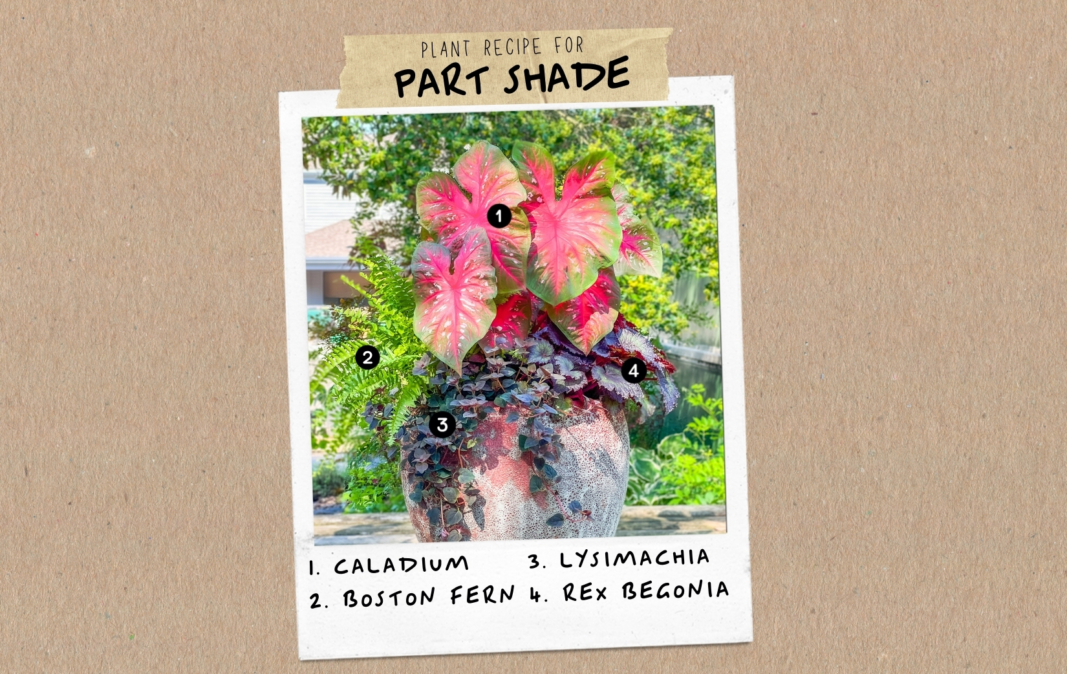
Big, Bold & Beautiful Container for Part Shade
This container design is particularly striking with the gigantic caladium blooms offset by the dark, weeping foliage of the chocolate lysimachia and bright green spray of the fern. The red coloring of the caladium and the deep hues of both the lysimachia and the rex begonia match the color of the container, keeping the style consistent and complementary. The plants in this container will perform best in partial sun, away from the harsh afternoon rays.
Plants Featured
Caladium
Caladiums grow as tropical annuals and are known for their very showy foliage coming in a wide range of colors and patterns. If you’d like to move your caladium out of the container, gardeners have luck planting them directly into the garden as well as keeping them indoors as a houseplant. When planting it into a container, caladiums do not enjoy cold soil and thrive if you plant them when the soil is warm.
Boston Fern
Boston ferns are evergreen and overwinter very well indoors. They will thrive in partial sun exposure. Keep your ferns out of strong afternoon sunlight as it will burn the fronds.
Chocolate Lysimachia
Chocolate lysimachia is an annual that has deep, vibrant cascading foliage. If you’re looking to take your lysimachia out of the container and place it somewhere else, this plant will work well as an annual ground cover, spreading throughout the garden. If it is very happy, it will bloom small yellow flowers in late spring.
Rex Begonia
Rex begonias are perennials that can thrive both outdoors and indoors. Their foliage is often multicolored, variegated and textured. It will bloom small, white and pink flowers throughout the summer season. When winter comes, move your rex begonia inside near an East-facing window or just outside of direct light in a South-facing window.
Planting Instructions
If you’re looking to replicate this container in your own home, follow our step by step potting instructions. Here is an abbreviated version.
1. Select a container. Choose a container with drainage holes. This allows excess water to drain out of the bottom of the pot, letting the roots take in the oxygen they need to survive. When choosing a container, consider the size of the plants you’re planning to put into it. You want to allow plenty of room for root growth. The larger the pot, the more soil you can use, meaning there is more room for growth and it is easier to keep that soil moist.
2. Add Merrifield Potting Mix. We recommend using a well draining potting soil to allow adequate moisture and oxygen balance for optimal plant health. Before you pour in your soil, place a piece of landscape fabric or a coffee filter over the drainage holes in your container. This will prevent soil from leaking out of the holes. Add Merrifield Potting Mix until the container is around ⅔ full.
3. Add a slow release fertilizer. Mix a slow release plant food, such as organic Plant Tone, into the soil. This will provide a continual release of nutrients for your plants to thrive. Follow the instructions on the bag for the amount of fertilizer to add based on the size of your container. Continue to fertilize in the summer.
4. Add your plants. Before placing your plants into the soil, we suggest arranging your plants in their growers pots to see what the layout will look like when they are planted. Then, working with the tallest plant first, caladium in this instance, remove the growers pot and loosen the roots, tucking the plant into your fertilized soil. Continue planting with the fern, chocolate lysimachia and rex begonia in the same way. As you’re planting, you can tuck in more potting soil as you need it. The goal is to keep the soil around 1” below the lip of the container when you are finished planting.
5. Top dress your container. Use decorative ⅜” rocks or mulch in a thin layer over the surface of your soil to help retain moisture, keep critters out of the soil, and keep the soil in the pot when watering.
6. Water thoroughly. After everything is planted, water thoroughly until the soil is moist and water comes out of the drainage holes of your container. If you’re placing the container on a wood surface like a deck or a balcony, we suggest using a saucer or plant toes or plant feet to keep the container lifted off of the ground so that excess water does collect under your pot and potentially damage your surface.
7. Fertilize throughout the growing season. We recommend reapplying Plant Tone two or three times during the growing season, pouring it directly on top of the soil. If you’re using a decorative soil cover, push it aside to place the Plant Tone directly on the soil surface. Follow the instructions on the bag for the amount to apply for continual feeding.
Ongoing Care
Watering
The plants in this container will thrive with moist soil. You do not want the soil to completely dry out or remain soaking wet. In general, you will likely need to check the soil for water every 1 to 2 days. Use your finger to reach into the soil a few inches deep and feel if the soil is wet or dry. If the soil is beginning to dry out, water thoroughly until the soil is totally saturated and feels like a soaking wet sponge and water runs through the drainage holes of the container.
Overwintering
Caladiums, Boston Ferns and Rex Begonias can be moved indoors in the wintertime. Either take the whole container and move it indoors or separate the plants and put them in different containers to enjoy individually.



